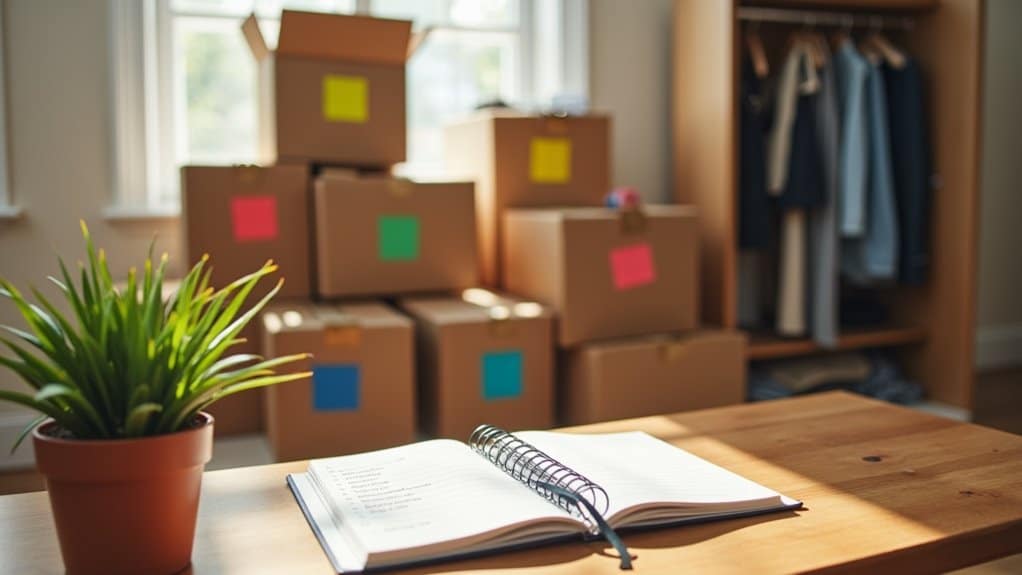
A Guide to Organizing Your Home Before a Domestic Move
Organising your home before a domestic move can make the process much smoother. Start by creating a detailed timeline and budget, including all potential expenses. Then, declutter each room individually, sorting items into "Keep," "Donate," and "Discard" piles. Begin packing the least used rooms first, ensuring fragile items are wrapped safely and boxes are labelled clearly. When you arrive at your new home, prioritise unpacking essentials like kitchenware and bedding. Lastly, update your contacts and complete any final tasks. Following these steps will help ensure a more straightforward move. There are additional tips that can further simplify your relocation.
Key Takeaways
- Create a detailed moving timeline 2-4 months in advance to stay organised and prevent last-minute stress.
- Declutter each room by sorting your belongings into "Keep," "Donate," "Sell," and "Bin" piles to make packing easier.
- Begin packing non-essential items first, using clear labels and designating a specific packing area for better organisation.
- Prepare essentials boxes for frequently used items so you have easy access during the unpacking process.
- Inform utility providers and update your address with relevant institutions to simplify your move to the new home.
Planning Your Move
When planning your move, it's crucial to establish a timeline to prevent last-minute chaos. Start by assessing how complex your move will be, taking into account factors such as stairs and parking that could affect the process. Evaluate complexity to ensure you're prepared for any challenges that may arise.
Eight weeks before your move, decide how you'll get help—will you ask friends and family, or hire a professional moving service? Create a moving binder to keep all important documents tidy. Check your insurance to ensure your belongings are covered during transit. Begin an inventory of your rooms, measuring items and deciding what to keep or discard.
At six weeks out, start your decluttering process. Sort your items into categories: keep, donate, and discard. Develop a packing schedule based on the number of rooms you're vacating.
As you get to four weeks before the move, assess your storage needs and consider renting a unit if needed. Confirm your moving arrangements and research local services, such as schools, to ensure a smooth transition.
In the final week, pack your essentials, disassemble any large furniture, and do a final walkthrough of your current home. Check the weather forecast and keep some cash handy for any unexpected expenses on moving day.
Setting a Budget
Setting a budget for your move begins with estimating your costs, so you know what to expect.
Don't forget to factor in hidden expenses like packing materials, insurance, and any potential storage fees. Unexpected costs can arise unexpectedly, making it essential to have a contingency plan in place.
A clear budget will help you plan effectively and steer clear of financial surprises on moving day.
For example, if you're hiring a removal company, research their fees and include that in your budget. Additionally, consider obtaining multiple moving estimates to ensure you find the best deal for your needs.
Estimate Moving Costs
Estimating moving costs is crucial for keeping your budget in check and avoiding unexpected expenses. First, decide if you need a volume estimate or an hourly rate.
For long-distance moves, calculate the volume of your belongings alongside mileage and any special considerations to get a precise cost estimate. This usually involves pricing per cubic metre. Additionally, consider the cost of legal fees associated with property transactions, as they can significantly impact your overall budget.
For local moves, focus on hourly rates, which include a charge per hour plus travel fees. Be mindful of minimum hours required and any potential extra charges. When setting your budget, include costs for professional movers, packing materials, and any temporary storage you might need. Additionally, consider how the timing of the move can influence rates, as moving during peak seasons can lead to higher charges.
Keep in mind that the weight and volume of your items will directly impact your overall costs—more items will require more manpower and possibly a larger vehicle. Also, remember to factor in accessibility issues and any special requirements that could affect your estimate. It may also be wise to consider moving insurance to protect your belongings during the transition.
Include Hidden Expenses
Even with a reliable estimate of your moving costs, hidden expenses can quickly add up and catch you off guard. Start by considering packing essentials like boxes, tape, and protective materials. These costs can escalate, especially for larger homes or delicate items. It's wise to evaluate the potential costs of professional packing if you have valuable or fragile items that require careful handling.
If you're hiring professional movers, remember to factor in the cost of packing services and any fees for disassembling and reassembling furniture. Additionally, negotiating with moving companies can help you secure better rates and minimize costs.
Next, think about utility setup fees. Many overlook charges for setting up electricity, water, and gas at your new home. Don't forget about disconnection fees from your old property, either.
Additionally, internet and cable installation costs can hit your budget harder than anticipated.
Logistical costs such as storage fees for items you can't move immediately and long carry charges if movers can't park close to your home can be unexpected. You might also need temporary accommodation.
Finally, don't forget about post-move expenses like home repairs, restocking household essentials, and even change of address fees. By planning for these hidden costs, you can avoid budget surprises and keep your move on track.
Understanding New Home Needs
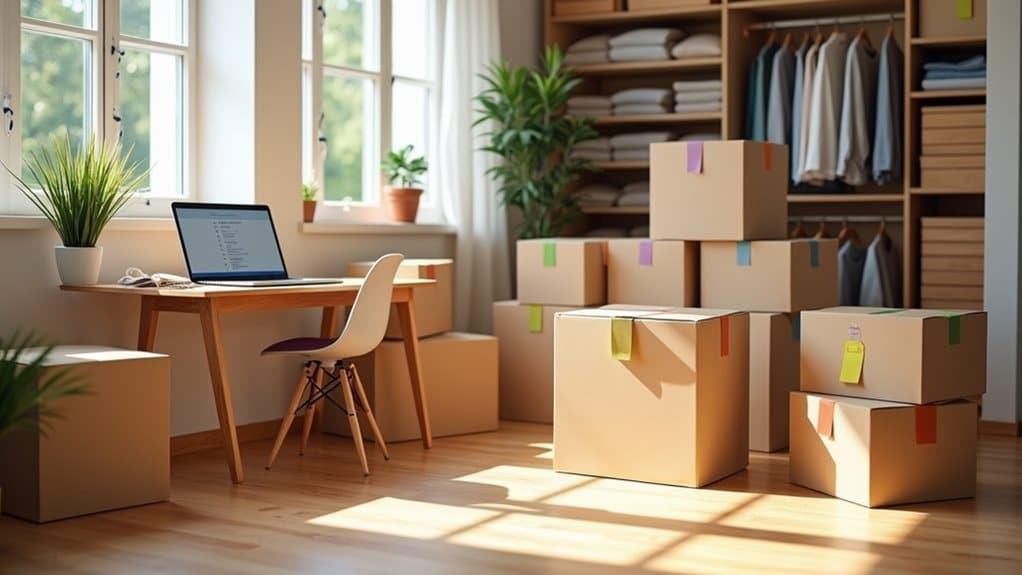
When moving into a new home, it's crucial to understand your needs for a seamless transition. Start by assessing your requirements for various areas of your home to ensure you have the right essentials and safety measures.
Consider these key categories:
- Safety and Maintenance
- Install smoke alarms, carbon monoxide detectors, and fire extinguishers.
- Schedule seasonal maintenance tasks like roof inspections and cleaning windows. Additionally, be prepared for post-move expenditures as they can impact your budget after settling in.
- Room Essentials
- Stock your kitchen with pots, pans, and cutlery.
- Set up your bedroom with a comfortable mattress, bedding, and storage solutions.
- Office Setup and Guest Accommodations
- Create a functional home office with a desk, chair, and printer.
- Prepare your guest room with a bed, wardrobe, and necessary amenities.
Don't overlook outdoor supplies, such as garden tools and doormats, to keep your property in good shape.
Creating a Detailed Timeline
Creating a detailed timeline is crucial for a smooth moving process. Start setting your timeline around 2-4 months before your moving date.
In the first 5-7 weeks, gather packing supplies such as boxes, tape, and markers. Don't forget essentials like dollies, straps, and moving blankets for heavier items.
4-6 weeks before the move, sort through your belongings. Create a checklist to help you decide what to keep, donate, or throw away.
Plan to dispose of any hazardous materials during this period.
As you near the 3-week mark, start packing items you don't use often, like seasonal decorations. Clearly label each box with its intended room in your new home.
Two weeks before moving, focus on your kitchenware and set aside "Open Me First" items—those essentials you'll need immediately.
In the final week, ensure all remaining items are packed, boxes are securely sealed, and that you haven't packed away any essentials.
Review your packing to catch anything you might've missed, and organise your checklist for a stress-free moving day.
Starting the Decluttering Process
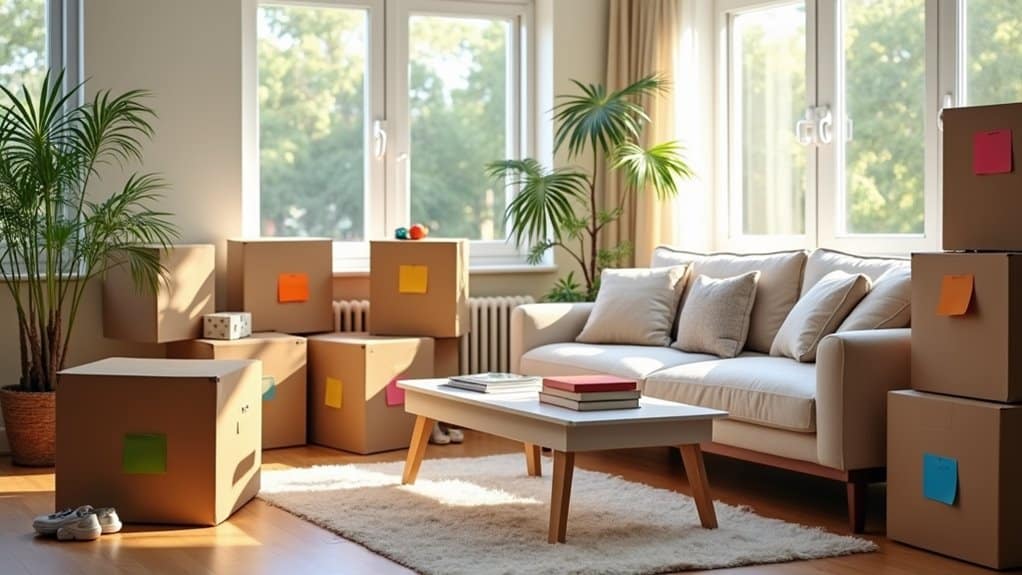
Starting the decluttering process can feel daunting, but tackling it room by room makes it manageable.
Begin by taking stock of your home. Identify which items you can keep, donate, or throw away. As you move through each room, think about how often you use each item and whether it's truly necessary. Visualise how your new space will fit your belongings.
Here are three straightforward steps to guide you:
- Start Small: Focus on one room or category at a time. Areas like kitchens and hall cupboards often gather unnecessary clutter.
- Create Piles: Set up separate piles for "Keep" and "Donate/Sell" to simplify your decisions. Try not to let emotional attachments affect your choices—embrace a minimalist mindset.
- Organise Supplies: Gather boxes for rubbish, donations, and items that require action. Label everything clearly to avoid confusion.
Set aside items you won't need before the move, packing them in labelled boxes. Aim for 15 to 30 minutes each day for decluttering to keep your momentum going.
Effective Sorting Techniques
When sorting your belongings, using effective techniques can greatly simplify the process.
Begin by creating four distinct piles: "keep," "donate," "sell," and "discard." This approach helps clarify your choices and makes decision-making much easier.
For instance, items you no longer use but are in good condition can be set aside for donation or sale, while worn-out items can go straight to the discard pile.
Decluttering Strategies
Many people find that effective sorting techniques can significantly ease the decluttering process before a move. Embracing a minimalist mindset helps you confront emotional attachments to items more objectively.
Start early to give yourself plenty of time to assess each possession thoroughly.
Here are three practical strategies to streamline your decluttering:
- Break Down the Task: Tackle one area at a time. This approach makes the process less daunting and allows for a more systematic method. Use photos of your new home to help guide your decisions.
- Utilise a Decluttering Kit: Gather trash bags, sorting containers, and labels. This keeps everything organised and helps you dispose of excess clutter efficiently.
- Establish Logical Categories: Sort items into categories like "discard," "relocate," or specific uses such as kitchen utensils. This method simplifies decision-making and eases the emotional strain of letting go.
Sorting Methods
Sorting your belongings effectively can greatly ease the moving process. Start by creating broad categories such as clothing, kitchenware, and electronics. Use clear containers to keep loose items organised within these categories for easy visibility.
Begin with a rough sort, making "Purge" and "Relocate" piles. Then, categorise your items based on their function or usage. Set up a large, flat surface like a table or bed as your sorting area. Keep bin bags handy for things you want to discard, and label your containers for quick identification.
As you assess each item, consider the space in your new home to ensure everything fits. Group similar items together to keep the process focused.
Once sorted, assign a permanent home for each item, storing frequently used ones within easy reach. By following these sorting techniques, you'll simplify your move and make unpacking much easier.
Packing Strategies
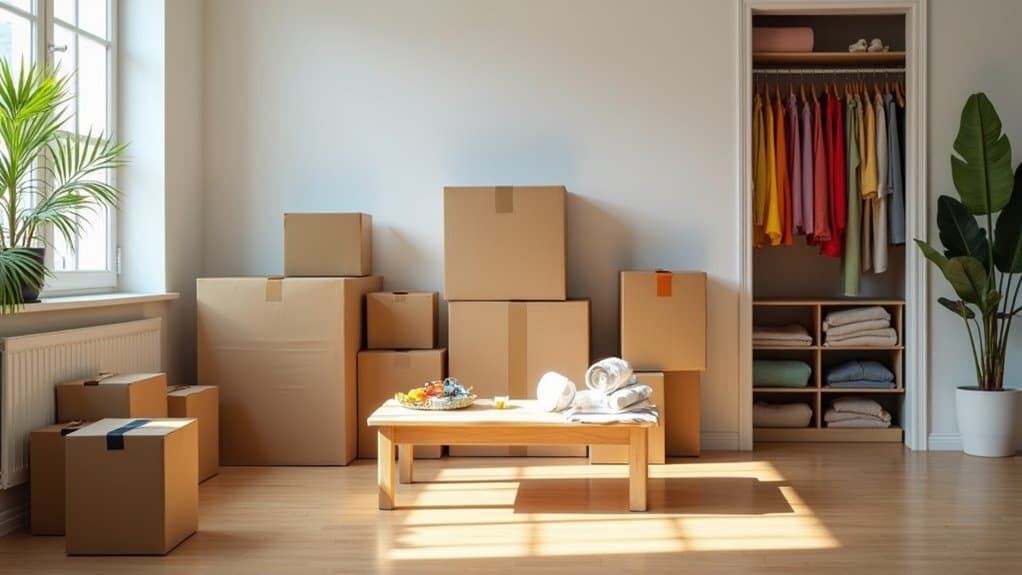
Packing strategies can greatly impact the success of your move. Start by packing the least used rooms first, such as guest bedrooms, attics, or basements, focusing on non-essential items. Be sure to label your boxes clearly, specifying the contents and the intended room to simplify unpacking.
Consider these three effective packing strategies:
- Maximise Space: Roll your clothes to save space and prevent creasing. Packing cubes can help keep items organised, while vacuum-seal bags are ideal for bulky clothes and bedding.
- Protect Fragile Items: Wrap delicate items in bubble wrap or packing paper to prevent damage. Use padding within boxes to stop items from shifting, and mark boxes as fragile to ensure careful handling.
- Distribute Weight: Place heavier items in smaller boxes and lighter items in larger ones. This makes carrying easier and reduces the risk of damage.
Organizing Your Packing
Once you've established effective packing strategies, the next step is to organise your packing for a smoother experience. Begin by creating a timeline, ideally around eight weeks before your move. Set up a dedicated packing area with all the necessary supplies and prioritise which rooms to tackle first. Start with less frequently used spaces, like spare bedrooms, and declutter as you go along.
Here's a quick reference table that includes useful packing tips and organising solutions:
| Packing Tips | Organising Solutions | Essential Practices |
|---|---|---|
| Create a packing schedule | Sort items by category | Pack essentials separately |
| Use colour-coded labels | Clearly label each box | Pack heavy items first |
| Maximise vertical space | Utilise bins and baskets | Store items logically |
| Designate an unpacking area | Unpack room by room | Use an unpacking checklist |
| Assign specific packing days | Simplify unpacking systems | Set up essentials first |
Following these strategies will make the packing and unpacking process far more manageable.
Efficient Moving Practices
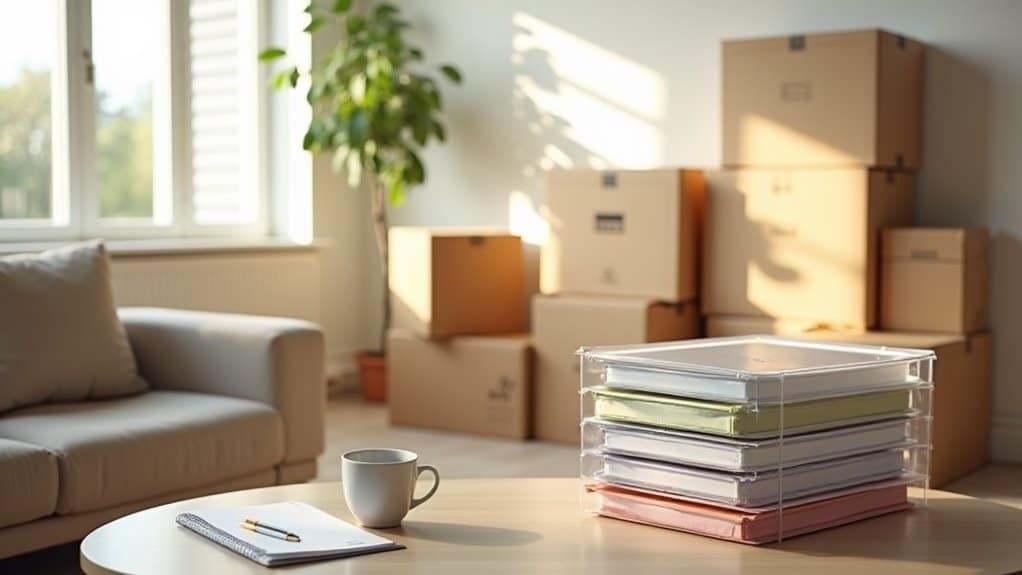
Efficient moving practices are key to reducing stress and ensuring a smooth transition to your new home.
Here are three essential tips for effective packing:
- Room-by-Room Packing: Tackle one room at a time to keep things organised. Start with less-used spaces, like spare bedrooms, to minimise disruption to your daily routine.
- Categorise and Label: Group similar items together and clearly label each box with its contents and the room it belongs to. This will make unpacking a breeze.
- Declutter While Packing: As you pack, sort items into three categories: keep, throw away, and donate. This not only lightens your load but also simplifies the packing process.
Utilizing Professional Help
When faced with the daunting task of moving, hiring professional help can make a significant difference. Professional organisers bring expert knowledge in decluttering and organising, helping to alleviate the stress that often comes with chaos and disorganisation. They provide tailored solutions that fit your specific needs and lifestyle, making the whole process more efficient.
By employing a professional organiser, you can save valuable time and energy. They can swiftly declutter and organise essential areas like wardrobes, kitchens, and storage spaces, allowing you to concentrate on other moving tasks. Their services might also include unpacking and managing the move, which can ease your transition into your new home.
In terms of cost, hiring a professional organiser typically ranges from £60 to £120 per hour, depending on the complexity of the job and your location. It's advisable to obtain quotes from several organisers to ensure you find one that suits your budget.
When searching for the right professional, look for those with experience in areas similar to yours, read reviews, and check that their methods align with your preferences.
With the right assistance, you can transform a stressful move into a well-organised experience.
Organizing in the New Home
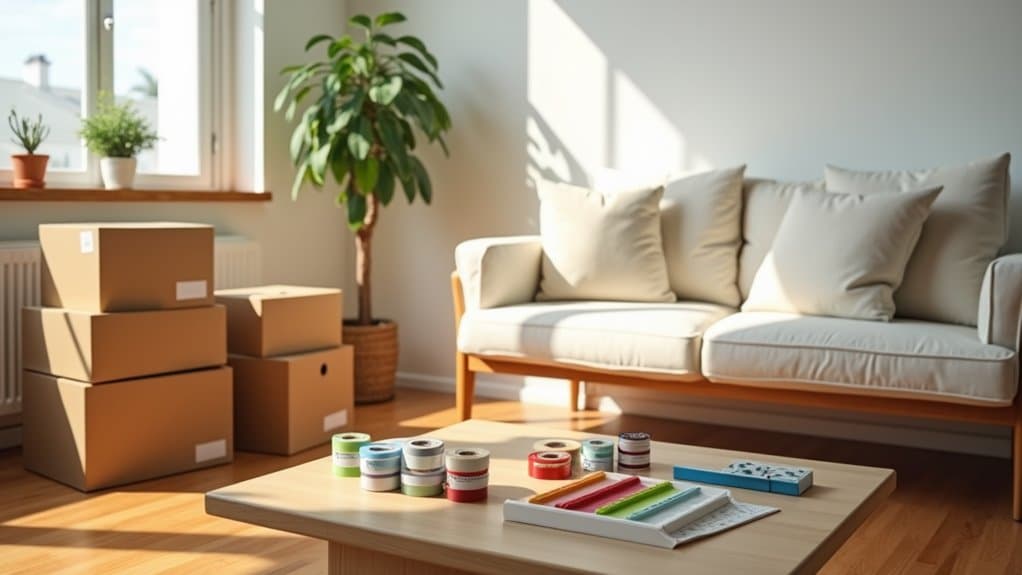
With professional help behind you, it's time to focus on organising your new home. Start with a clear plan that prioritises efficiency and accessibility. Here are three essential steps to guide you:
- Room Labeling: Clearly label each box with its intended room, and consider colour coding for easy identification. This will streamline your unpacking process.
- Furniture Layout: Sketch a layout of your space before moving in large furniture items. This helps establish a flow that enhances usability.
- Unpacking Essentials: Start unpacking key areas first, like the kitchen and bathroom. Prepare essentials boxes to keep frequently used items handy, and maintain an unpacking timeline to track your progress.
Keep cleaning supplies accessible as you unpack to ensure your space stays tidy.
Assign homes for everything, making sure each item has a designated place. Invest in storage solutions like bins and shelves to simplify organisation.
Finalizing Preparations
Finalising your preparations is crucial for a smooth moving day. Start by prioritising your packing. Begin with non-essential items, then move on to essentials like toiletries and a change of clothes. Clearly label each box with its contents and the room it belongs to for easier unpacking.
Next, address your cleaning checklist. Clean each room thoroughly, or consider hiring a cleaning service. Don't overlook closets and cabinets for any items you might've left behind. Schedule a final walkthrough to check for any damage and ensure the property is left in good condition.
Confirm logistics with your moving company, double-checking dates and times. Review your moving checklist to ensure all tasks are complete.
Prepare for moving day by getting a good night's sleep and having necessary supplies ready. Pack an essentials box with items like toilet paper and snacks for easy access. Finally, make sure you have cash on hand for tips and any unexpected expenses.
Updating Important Contacts

Updating important contacts is crucial to ensure a smooth transition to your new home. By prioritising your notifications, you can minimise disruptions.
Follow these steps to ensure everyone who needs your new address is informed:
- Notify Utilities: Contact your water, electricity, and gas providers about your moving date and shut-off dates. Remember to inform your broadband and television providers to prevent service interruptions.
- Inform Government and Financial Institutions: Update your address with the DVLA, HMRC, and your bank to ensure you receive important documents without delays. This also includes notifying the Department for Work and Pensions and updating billing addresses for associated services.
- Reach Out to Health and Educational Contacts: Let your healthcare providers, insurance companies, and schools know about your new address. You may need to arrange the transfer of medical records as necessary.
Use efficient contact methods, such as emails or online forms, to make this process easier.
Keeping a checklist handy will help you track your progress and ensure you don't overlook any important contacts.
Reviewing Your Moving Plan
As you review your moving plan, begin by checking important dates to ensure everything is on track.
Adjust your budget to reflect any changes in moving costs or unforeseen expenses. This will help you stay organised and ready as moving day approaches.
For example, if you find a cheaper removal company, update your budget accordingly to avoid overspending.
Assess Key Dates
When preparing for a move, assessing key dates is crucial for staying organised and on track.
A clear timeline helps you create a moving checklist, ensuring nothing is overlooked.
Here's a straightforward breakdown of important milestones to keep in mind:
1. 8 Weeks Before: Set your moving budget, research removal services, and decide whether to opt for DIY or hire professional movers.
Create a moving binder to organise all your documents and mark key packing days in your calendar.
2. 6 Weeks Before: Book your movers and gather packing supplies.
Confirm all arrangements and research new local services, such as schools or pet care, while continuing to pack your belongings.
3. 1 Week Before: Finish packing and clean your old home.
Prepare essentials, gather important documents, and ensure everything is properly labelled.
Don't forget to schedule a final walk-through of your old property.
Adjust Budget Accordingly
Adjusting your budget is crucial to ensure your move stays within financial limits. First, determine the type of move—local, long-distance, or international—as this will affect your costs.
Create a detailed budget, breaking it down into categories such as packing materials, moving company fees, and utility connections. List expenses within each category for accurate cost estimates.
To maintain budget flexibility, allocate funds to each category according to your spending limits. Research and compare prices for moving services and packing supplies to find the best deals.
Regularly update your budget as new expenses come up, and track your spending with a budget spreadsheet to avoid surprises.
Consider DIY options like packing your belongings or hiring a van to save money. Obtain quotes from several moving companies to ensure you get the best price.
Also, check if your home insurance covers your belongings during the move. By keeping a close eye on expenses and making informed adjustments, you can keep your move within budget and minimise financial stress.
Frequently Asked Questions
How Do I Decide What to Keep or Discard?
To determine what to keep or discard, evaluate each item's usefulness, condition, and how often you use it. For example, if you haven't worn a coat in two winters, it might be time to let it go. Use decluttering techniques like sorting items into categories and setting limits on how much you keep. This approach will help you make sensible decisions about your belongings.
What Are the Best Packing Materials to Use?
For packing, use bubble wrap for delicate items, strong boxes for organisation, and packing paper for flexible cushioning. Remember to have a tape dispenser handy, moving blankets for extra protection, packing peanuts for filling empty spaces, and a good labelling system.
How Can I Handle Sentimental Items During Decluttering?
When dealing with sentimental items, evaluate your emotional attachment and focus on preserving memories. Retain items that bring you joy, digitise others for simpler storage, and take a moment to appreciate each decision you make during the decluttering process. For instance, consider keeping a few cherished photographs while scanning others to save space.
What Should I Do With Hazardous Materials?
Identify hazardous materials, sort them, and use safe storage solutions. Research local hazardous waste disposal regulations for proper disposal methods, such as home collection or drop-off points. This ensures compliance and safety. For instance, batteries and paint are common hazardous materials that require special handling.
How Can I Make Moving Day Less Stressful?
Consider moving day as a marathon rather than a sprint. To keep stress at bay, create a checklist, take regular breaks, and use stress reduction techniques to maintain your energy and calm. For instance, you could pack a few boxes in the morning, then enjoy a cup of tea to recharge. Remember, you've got this!
Conclusion
As you stand in your new home, with boxes stacked high, take a moment to breathe. You've organised and prepared, making room for new memories. This isn't just a move; it's the start of a new chapter. Embrace the calm after the chaos, knowing you've set the stage for a life that suits you perfectly. Now, fill those rooms with laughter, love, and all the little things that turn a house into a home.


